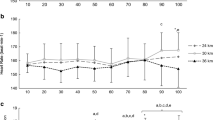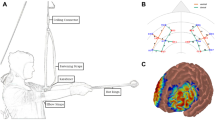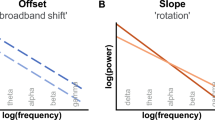Abstract
The aim of this current opinion article is to provide a contemporary perspective on the role of brain regulatory control of paced performances in response to exercise challenges. There has been considerable recent conjecture as to the role of the brain during exercise, and it is now broadly accepted that fatigue does not occur without brain involvement and that all voluntary activity is likely to be paced at some level by the brain according to individualised priorities and knowledge of personal capabilities. This article examines the role of pacing in managing and distributing effort to successfully accomplish physical tasks, while extending existing theories on the role of the brain as a central controller of performance. The opinion proposed in this article is that a central regulator operates to control exercise performance but achieves this without the requirement of an intelligent central governor located in the subconscious brain. It seems likely that brain regulation operates at different levels of awareness, such that minor homeostatic challenges are addressed automatically without conscious awareness, while larger metabolic disturbances attract conscious awareness and evoke a behavioural response. This supports the view that the brain regulates exercise performance but that the interpretation of the mechanisms underlying this effect have not yet been fully elucidated.


Similar content being viewed by others
References
Low D, Gramlich M, Engram B. Self-paced exercise program for office workers: impact on productivity and health outcomes. AAOHN J. 2007;55:99–105.
Day M, McGuigan MR, Brice G, Foster C. Monitoring exercise intensity during resistance training using the session RPE scale. J Strength Cond Res. 2004;18:353–8.
Impellizzeri F, Rampinini E, Coutts AJ, Sassi A, Marcora SM. Use of RPE-based training load in soccer. Med Sci Sports Exerc. 2004;36:1042–7.
White P, Sharpe MC, Chalder T, DeCesare JC, Walwyn R. Protocol for the PACE trial: a randomised controlled trial of adaptive pacing, cognitive behaviour therapy, and graded exercise as supplements to standardised specialist medical care versus standardised specialist medical care alone for patients with the chronic fatigue syndrome/myalgic encephalomyelitis or encephalopathy. BMC Neurol. 2007;7:1–20.
Ekkekakis P. Let them roam free? Physiological and psychological evidence for the potential of self-selected exercise intensity in public health. Sports Med. 2009;39:857–88.
Edwards AM, Polman RCJ. Pacing in sport and exercise: a psychophysiological perspective. New York: Nova Scientific Publishers; 2012.
St Clair Gibson A, Lambert MI, Noakes TD. Neural control of force output during maximal and submaximal exercise. Sports Med. 2001;31:637–50.
Noakes TD. Time to move beyond a brainless exercise physiology: the evidence for complex regulation of human exercise performance. Appl Physiol Nutr Metabol. 2011;36:23–35.
St Clair Gibson A, Noakes TD. Evidence for complex system integration and dynamic neural regulation of skeletal muscle recruitment during exercise in humans. Br J Sports Med. 2004;38:797–806.
Noakes TD, St Clair Gibson A, Lambert EV. From catastrophe to complexity: a novel model of integrative central neural regulation of effort and fatigue during exercise in humans: summary and conclusions. Br J Sports Med. 2005;39:120–4.
St Clair Gibson A, Lambert EV, Rauch LGH, Tucker R, Baden DA, Foster C, Noakes TD. The role of information processing between the brain and peripheral physiological systems in pacing and perception of effort. Sports Med. 2006;36:705–22.
Mauger AR, Jones AM, Williams CA. Influence of feedback and prior experience on pacing during a 4-km cycle time trial. Med Sci Sports Exerc. 2009;41:451–8.
Micklewright D, Papadopoulou E, Swart J, Noakes T. Previous experience influences pacing during 20 km time trial cycling. Br J Sports Med. 2010;44:952–60.
Foster C, Schrager M, Snyder AC, Thompson NN. Pacing strategy and athletic performance. Sports Med. 1994;17:77–85.
Costill D, Thomason H, Roberts E. Fractional utilization of the aerobic capacity during distance running. Med Sci Sports. 1973;5:248–52.
Bassett D, Howley E. Limiting factors for maximum oxygen uptake and determinants of endurance performance. Med Sci Sports Exerc. 2000;32:70–84.
Noakes TD. Fatigue is a brain-derived emotion that regulates the exercise behaviour to ensure the protection of whole body homeostasis. Front Physiol. 2012;3:1–9.
Paterson S, Marino FE. Effect of deception of distance on prolonged cycling performance. Percept Mot Skill. 2004;98:1017–26.
Dugas J, Oosthuizen U, Tucker R, Noakes TD. Rates of fluid ingestion alter pacing but not thermoregulatory responses during prolonged exercise in hot and humid conditions with appropriate convective cooling. Eur J Appl Physiol. 2009;105:69–80.
Marino FE. Anticipatory regulation and avoidance of catastrophe during exercise-induced hyperthermia. Comp Biochem Physiol B Biochem Mol Biol. 2004;139:561–9.
Lambert EV, St Clair Gibson A, Noakes TD. Complex systems model of fatigue: integrative homoeostatic control of peripheral physiological systems during exercise in humans. Br J Sports Med. 2005;39:52–62.
Marcora SM, Staiano W, Manning V. Mental fatigue impairs physical performance in humans. J Appl Physiol. 2009;106:857–64.
Rauch H, St Clair Gibson A, Lambert EV. A signaling role for muscle glycogen in the regulation of pace during prolonged exercise. Br J Sports Med. 2005;39:34–8.
Rauch L, Rodger I, Wilson GR, Belonje JD, Dennis SC, Noakes TD, Hawley JA. Effects of carbohydrate loading on muscle glycogen content and cycling performance. Int J Sport Nutr. 1995;5:25–36.
Abbiss C, Laursen P. Describing and understanding pacing strategies during athletic competition. Sports Med. 2008;38:239–52.
Edwards AM, Lander PJ. Physiological responses to self-paced exercise: effort-matched comparisons across running and rowing modalities. J Sports Med Phys Fitness. 2012;52:344–50.
Lander PJ, Butterly RJ, Edwards AM. Self-paced exercise is less physically challenging than enforced constant pace exercise of the same intensity: influence of complex central metabolic control. Br J Sports Med. 2009;43:789–95.
Mauger AR, Jones AM, Williams CA. Influence of acetaminophen on performance during time trial cycling. J Appl Physiol. 2010;108:98–104.
Hargreaves M. Fatigue mechanisms determining exercise performance: integrative physiology is systems biology. J Appl Physiol. 2008;104:1541–2.
Magill R. Motor learning and control: concepts and applications. 9th ed. New York: McGraw Hill; 2011.
Tucker R. The anticipatory regulation of performance: the physiological basis for pacing strategies and the development of a perception-based model for exercise performance. Br J Sports Med. 2009;43:392–400.
Saunders AG, Dugas JP, Tucker R, Lambert MI, Noakes TD. The effects of different air velocities on heat storage and body temperature in humans cycling in a hot, humid environment. Acta Physiol Scand. 2005;183:241–55.
Tucker R, Bester A, Lambert EV, Noakes TD, Vaughan CL, St Clair Gibson A. Non-random fluctuations in power output during self-paced exercise. Br J Sports Med. 2006;40:912–7.
Tucker R, Rauch L, Harley Y, Noakes T. Impaired exercise performance in the heat is associated with an anticipatory reduction in skeletal muscle recruitment. Pflügers Archiv. 2004;448:422–30.
Corbett J, Barwood M, Ouzounoglou A, Thelwell R, Dicks M. Influence of competition on performance and pacing during cycling exercise. Med Sci Sports Exerc. 2012;44:509–15.
Swart J, Lindsay TR, Lambert MI, Brown JC, Noakes TD. Perceptual cues in the regulation of exercise performance—physical sensations of exercise and awareness of effort interact as separate cues. Br J Sports Med. 2012;46:42–8.
Noakes T. Testing for maximum oxygen consumption has produced a brainless model of human exercise performance. Br J Sports Med. 2008;42:551–5.
Midgley A, McNaughton LR, Polman RCJ, Marchant D. Criteria for determination of the maximal oxygen uptake: a brief critique and recommendations for future research. Sports Med. 2007;37:1019–28.
Edwards A, Noakes TD. Dehydration: cause of fatigue or sign of pacing in elite soccer? Sports Med. 2009;39:1–13.
Noakes TD. Physiological models to understand exercise fatigue and the adaptations that predict or enhance athletic performance. Scand J Med Sci Sports. 2000;10:123–45.
Hochachka P. The lactate paradox: analysis of underlying mechanisms. Ann Sports Med. 1988;4:184–8.
Ulmer H. Concept of an extracellular regulation of muscular metabolic rate during heavy exercise in humans by psychophysiological feedback. Experimentia. 1996;52:416–20.
Marcora S. Do we really need a central governor to explain brain regulation of exercise performance? Eur J Appl Physiol. 2008;104:929–31.
Tucker R, Noakes TD. The physiological regulation of pacing strategy during exercise: a critical review. Br J Sports Med. 2009;43:1–9.
Whittow G. Sturkie’s avian physiology. 5th ed. New York: Academic Press; 1999.
Portas CM, Rees G, Howseman AM, Josephs O, Turner R, Frith CD. A specific role for the thalamus in mediating the interaction of attention and arousal in humans. J Neurosci. 1998;18:8979–89.
Bridgeman B. Conscious vs. unconscious processes. Theory Psychol. 1992;2:73–88.
Vaneechoutte M. Experience, awareness and consciousness: suggestions for definitions as offered by an evolutionary approach. Found Sci. 2000;5:429–56.
Chalmers D. Facing up to the problem of consciousness. J Conscious Stud. 1995;2:200–19.
Crick F, Koch C. Are we aware of neural activity in primary visual cortex? Nature. 1995;375:121–3.
Gazzaniga M. Consciousness and the cerebral hemispheres. In: The cognitive neurosciences. Cambridge: MIT Press; 1996.
Masters RSW. Knowledge, knerves and know-how: the role of explicit versus implicit knowledge in the breakdown of a complex motor skill under pressure. Br J Psychol. 1992;83:343–58.
Acknowledgments
No funding was provided for the preparation of the paper. Neither author has any conflicts of interest. Both authors contributed fully to the preparation of this manuscript.
Author information
Authors and Affiliations
Corresponding author
Rights and permissions
About this article
Cite this article
Edwards, A.M., Polman, R.C.J. Pacing and Awareness: Brain Regulation of Physical Activity. Sports Med 43, 1057–1064 (2013). https://doi.org/10.1007/s40279-013-0091-4
Published:
Issue Date:
DOI: https://doi.org/10.1007/s40279-013-0091-4




